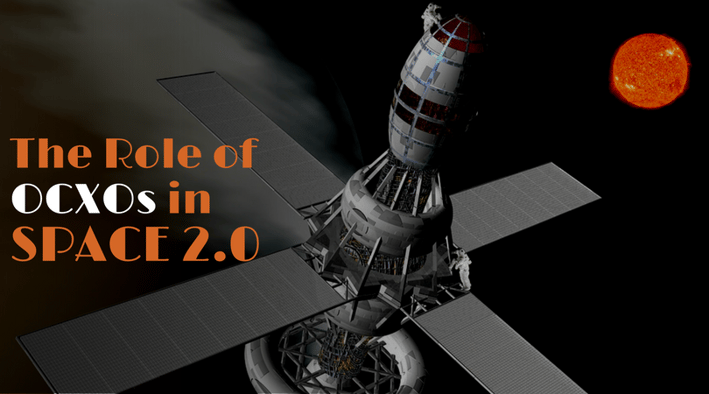
RF engineering is an indispensable part of human space activity. In both the commercial and government spheres, radio frequency signals serve as the backbone of all communication systems between spacecraft, satellites and their control centers on Earth, as well as critical satellite navigation and telecommunications infrastructure used on the surface.
While NASA and other government space agencies have been operating for decades, it increasingly appears that it is the private sector that will lead the way into the next phase of space-based innovation and exploration. If you’ve been following developments in space-related RF engineering, you’ve probably heard a new phrase that’s caught on in recent years. “Space 2.0” is a broad term which refers to a variety of new developments in space exploration, commercialization and more by privately-owned companies. A key enabler of this revolution in space tech and industry will be oven-controlled crystal oscillators (OCXO).
OCXOs and Space Applications
Oven-controlled crystal oscillators play an important role in broadcast, telecom, satellite and other space applications. Oscillators consist of an electrical circuit that uses the resonance of crystal vibrations (usually quartz) to generate a signal which vibrates at a specific
frequency. These frequencies can be put to several important uses in space, including transmission of messages and tracking time at extremely precise and minute levels. The ambient temperature around the crystal can affect the frequency. However, some crystal oscillators are built inside a special “oven” which encloses the crystal, maintaining it at the specific temperature at which it can perform most effectively.
This is especially important in space applications, given the extreme temperatures involved in outer space, as well as the atmospheric exit and reentry processes. Even in climate-controlled environments like a manned space station, oven controlled crystal oscillators are necessary and remain a key facilitator of reliable communication between space and the surface.
Space 2.0: New Challenges and Opportunities
Most engineers in the RF and aerospace industries know that the demand for satellites for navigation and telecommunication applications is only going to increase in the future. What is different about “Space 2.0” is that this new wave of investment in space tech will be driven by the private sector, rather than the military or government. (There will be more military-related space projects in the future, but that is outside the scope of this discussion.)
In the first Golden Age of space exploration during the Apollo program and others, the cost of launching payloads into orbit and beyond was prohibitively expensive for any entities except for governments of major countries. Over the past decade, however, there have been some game-changing developments in space technology. It is now far less expensive to send payloads into outer space, opening the door for private industry to begin investing in new projects that were once confined to the theoretical realm.
 Projects like asteroid mining, scientific research and exploration, space tourism and even colonization are on the horizon. Companies such as SpaceX, Blue Origin, and others are leading the way toward making space more accessible, and, perhaps indirectly, more democratic as well.
Projects like asteroid mining, scientific research and exploration, space tourism and even colonization are on the horizon. Companies such as SpaceX, Blue Origin, and others are leading the way toward making space more accessible, and, perhaps indirectly, more democratic as well.
If Elon Musk gets his way, soon Wi-Fi will be beamed all over the world from a network of over 4,000 SpaceX-owned satellites. A seed-funded company named Moon Express is researching the use of robotics for mining the moon, and a Washington-based company called Planetary Resources has a similar goal but is aiming at mineral-rich asteroids instead.
These ideas are not pipe dreams. The recent success of the European Space Agency in landing a probe on a comet in 2014 proves that such goals aren’t just science fiction anymore, but quite plausible and potentially very profitable.
One of the most ambitious projects is the colonization effort led by Mars One, which aims to put a permeant human settlement on the Martian surface by the early 2030s. It’s not a certain thing that people will succeed in building habitable structures on the red planet, but at the rate things are going, it shouldn’t be written off.
Tech investor and prominent futurist Peter Diamandis explained at the 2016 International Space Station R&D Conference how quickly space technology is advancing: “Breakthroughs in computation, networks, A.I. robotics, sensors, and transistor engineering mean we are moving from a linear progression of advancements in space tech, to an exponential one.” (source)
All of these projects will require the use of crystal oscillators and other advanced RF tech for communication, navigation, scientific research and more. This may be the dawn of the most exciting era of human space activity since the Mercury and Apollo days, and OCXO tech will play an essential role in bringing these amazing visions into reality. This is an exciting time to be working in RF engineering!
To learn more about how you can get in on the action, or how you can put Bliley’s proven OCXO solutions to work on your next project, just send us a quick message and we’ll be happy to help.






